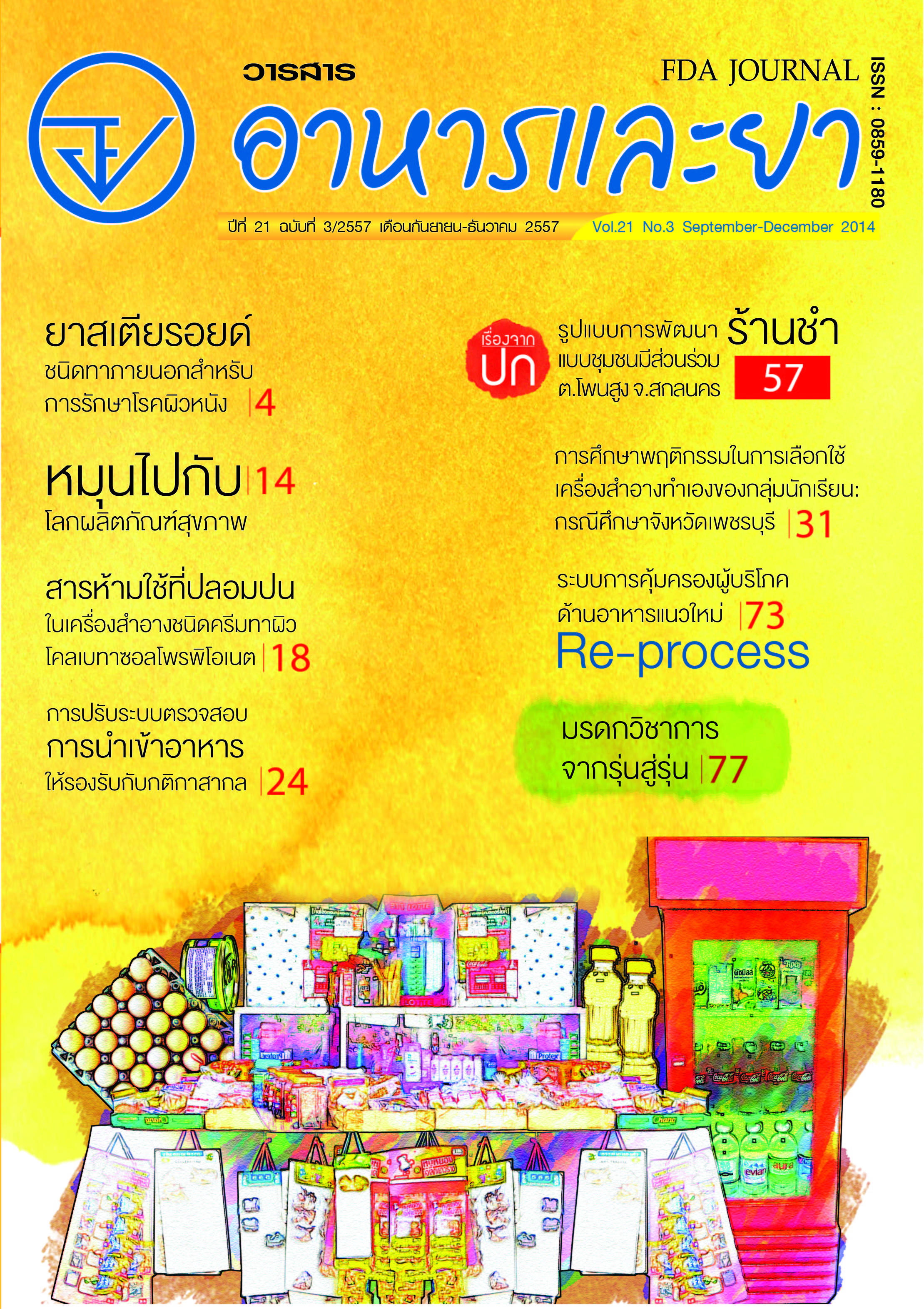การปรับระบบการตรวจสอบการนำเข้าอาหารให้รองรับกับกฎกติกาสากล
Main Article Content
บทคัดย่อ
การศึกษาครั้งนี้มีวัตถุประสงค์เพื่อศึกษาระบบการตรวจสอบการน
ําาเข้าอาหารของด่านอาหารและยา
ของประเทศไทยที่ด
ําาเนินการในปัจจุบันเปรียบเทียบกับแนวทางปฏิบัติส
ําาหรับระบบการควบคุมการน
ําาเข้า
สินค้าอาหาร (Guidelines for food import control systems: CAC/GL 47-2003) ของ CCFICS โดยการ
ใช้แบบสอบถามเจ้าหน้าที่ด่านอาหารและยาของประเทศไทยทั่วประเทศ จําานวน 38 คน ผลการศึกษาพบว่า
ใน 20 แนวทางปฏิบัติสําาหรับระบบการควบคุมการนําาเข้าสินค้าอาหารนั้น เจ้าหน้าที่ทั้ง 38 คนเห็นว่ามีการ
ปฏิบัติครบทั้ง 20 แนวทางอย่างครบถ้วน คิดเป็นร้อยละ 52.50 และมีการปฏิบัติครบทั้ง 20 แนวทาง แต่ยัง
ไม่ครอบคลุมทั้งหมด คิดเป็นร้อยละ 47.50 จากการศึกษานี้จะพบว่า สิ่งที่ด่านอาหารและยาของประเทศไทย
ยังไม่เคยดําาเนินการเลย มีด้วยกันหลายกระบวนงาน เช่น ระเบียบวิธีการสุ่มตัวอย่าง ข้อกําาหนดระหว่างการ
ขนส่งอาหาร การจัดเก็บค่าธรรมเนียมในการตรวจสอบและตรวจวิเคราะห์ การประเมินและยอมรับระบบ
ควบคุมอาหารของประเทศผู้ส่งออก การจัดทําาข้อมูลความเสี่ยงเพื่อกําาหนดความถี่ของการตรวจสอบ เกณฑ์
การตัดสินใจในการด
ําาเนินการกับสินค้าน
ําาเข้า การจัดการในสถานการณ์ฉุกเฉิน และการแลกเปลี่ยนข้อมูลระหว่าง
หน่วยงานราชการที่มีอ
ําานาจหน้าที่ของประเทศ ผู้ส่งออกและผู้น
ําาเข้า นอกจากนี้ มีข้อเสนอแนะให้ด่านอาหาร
และยาของประเทศไทย ต้องปรับปรุงการด
ําาเนินงานตามความจ
ําาเป็นเร่งด่วนล
ําาดับแรกคือ การจัดท
ําาระบบบริหาร
ความเสี่ยงเพื่อลดการตรวจสอบที่ไม่จ
ําาเป็น และจัดท
ําาหลักเกณฑ์การปฏิบัติที่ดีส
ําาหรับผู้น
ําาเข้า (Good Importing
Practice) เพื่อใช้ประกอบการประเมินผู้น
ําาเข้าและลดการตรวจสอบที่เป็นงานประจ
ําา สิ่งที่ต้องด
ําาเนินการ
ต่อไปคือ การจัดทําาและประกาศเกณฑ์การตัดสินใจดําาเนินการกับสินค้าที่ตรวจสอบ เพื่อให้เกิดความโปร่งใส
และเป็นธรรม และการออกกฎหมายให้มีการออกใบอนุญาตก่อนการส่งสินค้าเข้าประเทศ ทั้งนี้ในระยะยาว
ต้องศึกษาระบบควบคุมการน
ําาเข้าอาหารของประเทศคู่ค้า เพื่อเป็นข้อมูลในการประเมินระบบควบคุมและจัดท
ําา
ข้อตกลงร่วมระหว่างหน่วยงานราชการที่มีอ
ําานาจหน้าที่ของทั้งสองประเทศในการควบคุมอาหารให้ได้คุณภาพ
มาตรฐาน และปลอดภัยในการบริโภค ดังนั้นด่านอาหารและยาของประเทศไทย จึงต้องปรับระบบการ
ตรวจสอบอาหารน
ําาเข้า โดยการน
ําาหลักการของ CCFICS มาปรับใช้เพื่อให้นานาประเทศยอมรับในกระบวนการ
ตรวจสอบอาหารนําาเข้าของประเทศไทย
ําาเข้าอาหารของด่านอาหารและยา
ของประเทศไทยที่ด
ําาเนินการในปัจจุบันเปรียบเทียบกับแนวทางปฏิบัติส
ําาหรับระบบการควบคุมการน
ําาเข้า
สินค้าอาหาร (Guidelines for food import control systems: CAC/GL 47-2003) ของ CCFICS โดยการ
ใช้แบบสอบถามเจ้าหน้าที่ด่านอาหารและยาของประเทศไทยทั่วประเทศ จําานวน 38 คน ผลการศึกษาพบว่า
ใน 20 แนวทางปฏิบัติสําาหรับระบบการควบคุมการนําาเข้าสินค้าอาหารนั้น เจ้าหน้าที่ทั้ง 38 คนเห็นว่ามีการ
ปฏิบัติครบทั้ง 20 แนวทางอย่างครบถ้วน คิดเป็นร้อยละ 52.50 และมีการปฏิบัติครบทั้ง 20 แนวทาง แต่ยัง
ไม่ครอบคลุมทั้งหมด คิดเป็นร้อยละ 47.50 จากการศึกษานี้จะพบว่า สิ่งที่ด่านอาหารและยาของประเทศไทย
ยังไม่เคยดําาเนินการเลย มีด้วยกันหลายกระบวนงาน เช่น ระเบียบวิธีการสุ่มตัวอย่าง ข้อกําาหนดระหว่างการ
ขนส่งอาหาร การจัดเก็บค่าธรรมเนียมในการตรวจสอบและตรวจวิเคราะห์ การประเมินและยอมรับระบบ
ควบคุมอาหารของประเทศผู้ส่งออก การจัดทําาข้อมูลความเสี่ยงเพื่อกําาหนดความถี่ของการตรวจสอบ เกณฑ์
การตัดสินใจในการด
ําาเนินการกับสินค้าน
ําาเข้า การจัดการในสถานการณ์ฉุกเฉิน และการแลกเปลี่ยนข้อมูลระหว่าง
หน่วยงานราชการที่มีอ
ําานาจหน้าที่ของประเทศ ผู้ส่งออกและผู้น
ําาเข้า นอกจากนี้ มีข้อเสนอแนะให้ด่านอาหาร
และยาของประเทศไทย ต้องปรับปรุงการด
ําาเนินงานตามความจ
ําาเป็นเร่งด่วนล
ําาดับแรกคือ การจัดท
ําาระบบบริหาร
ความเสี่ยงเพื่อลดการตรวจสอบที่ไม่จ
ําาเป็น และจัดท
ําาหลักเกณฑ์การปฏิบัติที่ดีส
ําาหรับผู้น
ําาเข้า (Good Importing
Practice) เพื่อใช้ประกอบการประเมินผู้น
ําาเข้าและลดการตรวจสอบที่เป็นงานประจ
ําา สิ่งที่ต้องด
ําาเนินการ
ต่อไปคือ การจัดทําาและประกาศเกณฑ์การตัดสินใจดําาเนินการกับสินค้าที่ตรวจสอบ เพื่อให้เกิดความโปร่งใส
และเป็นธรรม และการออกกฎหมายให้มีการออกใบอนุญาตก่อนการส่งสินค้าเข้าประเทศ ทั้งนี้ในระยะยาว
ต้องศึกษาระบบควบคุมการน
ําาเข้าอาหารของประเทศคู่ค้า เพื่อเป็นข้อมูลในการประเมินระบบควบคุมและจัดท
ําา
ข้อตกลงร่วมระหว่างหน่วยงานราชการที่มีอ
ําานาจหน้าที่ของทั้งสองประเทศในการควบคุมอาหารให้ได้คุณภาพ
มาตรฐาน และปลอดภัยในการบริโภค ดังนั้นด่านอาหารและยาของประเทศไทย จึงต้องปรับระบบการ
ตรวจสอบอาหารน
ําาเข้า โดยการน
ําาหลักการของ CCFICS มาปรับใช้เพื่อให้นานาประเทศยอมรับในกระบวนการ
ตรวจสอบอาหารนําาเข้าของประเทศไทย
Article Details
รูปแบบการอ้างอิง
1.
บุญกิจอนุสรณ์ ส. การปรับระบบการตรวจสอบการนำเข้าอาหารให้รองรับกับกฎกติกาสากล. TFDJ [อินเทอร์เน็ต]. 8 สิงหาคม 2018 [อ้างถึง 25 ธันวาคม 2025];21(3):24-30. available at: https://he01.tci-thaijo.org/index.php/fdajournal/article/view/139047
ประเภทบทความ
รายงานการวิจัย


